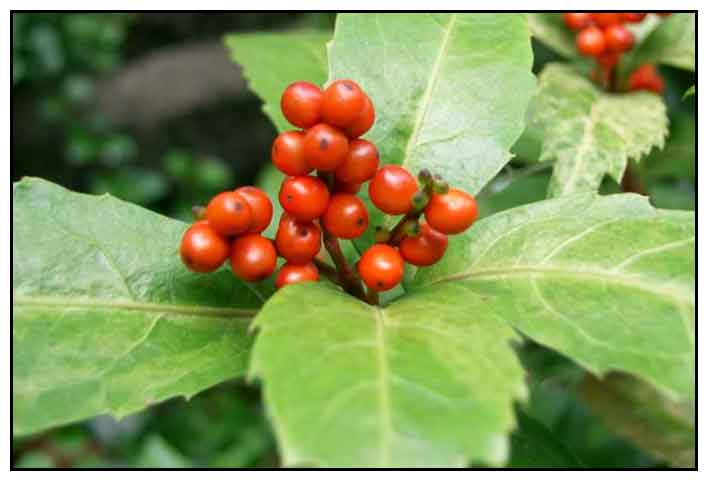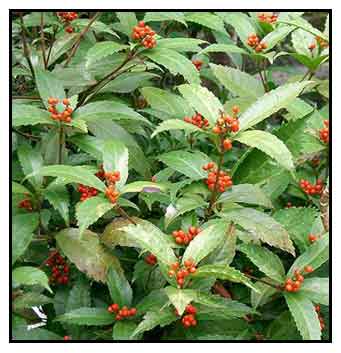 Botany Botany
Apot is a spreading undershrub, 60 to 90 centimeters tall. Stems and branches are terete, the latter opposite or in sub-whorls, and smooth. Leaves are opposed, with short petioles, narrowly oblong to lanceolate, 10 to 15 centimeters long, and only the larger ones 5 centimeters wide, leathery and smooth, with the margins (except near the base), toothed with sharp teeth and the tip pointed. Inflorescence is paniculately few-branched, upon a 3-centimeter long peduncle, with ascending spicate branches. Flowers are minute, sessile, with a subtended bract. Fruit is a rather small, one-seeded drupe, with somewhat juicy flesh and vermilion-red skin.
 Distribution Distribution
- Common and widely distributed in the Philippines in primary forests at medium and higher altitudes.
- Also occurs in India to Japan, southward to Malaya.
Constituents
- Study yielded 11 compounds: shizukanolide, furanodienone, lupeol, 24-hydroxylupeol, pinostrobin, 2', 6'-dihydroxy-4'-methoxydihydrochalcone, 7-rnethylnaringenin, eleutheroside B1, 3,4-dihydroxybenzonic acid, palmitic acid and β-sitosterol.
- Yields terpenoids, flavanoids, coumarins and phenolic acids.
- Study yielded two new sesquiterpenes: glabranols A and B. (4)
- Chloroform and EtOH extracts yielded six compounds, viz. 4, 4'-biisofraxidin, esculetin, fraxetin, scoparone, isofraxidin, scopoletin. (See study below) (11)
- Study of 70% aqueous acetonic extract of whole plant yielded a new eudesmanolide sesquiterpene, atractylenolide IV, together with 7 known compounds. (see study below) (14)
- Study yielded flavonoid glycosides identified as kaempferol-3-O-beta-D-glucuronide (1), quercetin-3-O-alpha-D-glucuronide (2), quercetin-3-O-beta-D-glucuronopyranoside methyl ester (3), 5, 7, 4'-trihydroxy-8-C-beta-D-glucopyranosyl flavanone (4), neoastilbin (5), 5-O-caffeoylquinic acid methyl ester (6), 3, 4-dihydroxybenzoic acid (7), isofraxidin (8). (17)
- Total water extract part chloroform extract yielded nine compounds identified as isofraxidin(1), 8-methoxy- 6,7-methylenedioxy-coumarin (2), 7-methylnaringenin (3), kaempferol (4), kaempferol-3-O- rhamno- pyranosyl (1→6)glucopyranoside (5), eleutheroside B1 (6), isofraxidin-7-O-β-D-xylopyranosyl (1- 3)-α-D-glucopyranoside (7), rosmarinic acid (8), 3,4-dihydroxyphenethyl caffeate (9).
(19)
- Study of whole plant yielded a new phenolic acid glycoside, benzyl 2-β-glucopyranosyloxybenzoate (1), together with seven known compounds including eleutheroside B1 (2), 5-O-caffeoylshikimic acid (3), (–)-(7S, 8R)-dihydrodehydro- diconiferyl alcohol (4), (–)-(7S, 8R)-dihydrodehydrodiconiferyl alcohol 9-, 9′- and 4-O-â-D-glucopyranoside (5–7), and (–)-(7S, 8R)-5-methoxydihydrodehydrodiconiferyl alcohol 4-O-β-D-glucopyranoside (8). (see study below) (27)
- Study of 70% EtOH extract of whole plant of Sarcandra glabra isolated four sesquiterpenoids, namely: 4-alpha-hydroxy--5-alpha-H-lindan-8 (9)-en-8, 12-olide (1), chloranthalactone E (2), 8-beta, 9-alpha-dihydroxylindan (5), 7-(1)-ieb-8-alpha, 12 olide (3) and chloranoside A (4). Compound 1 is a new sesquiterpene lacone.
(33)
Properties
- Both warm and sweet, detoxifying, anti-inflammatory.
- Studies have suggested anti-tumor, immunoprotective, anticancer, antibacterial, hepatoprotective, anti-inflammatory, radioprotective properties.
Parts used
Whole plant, leaves.
Uses
Edibility
In Malaya, leaves reportedly used to scent tea or added to tea for bulk.
Folkloric
- Infusion of the plant used for headaches.
- In traditional Chinese medicine used for treatment of bruises, bone fractures, arthritis, nausea, joint swelling and cough.
- An herb included in Chinese Pharmacopoeia used as anti-tumor, antibacterial, anti-inflammatory, and for increasing blood platelets.
- In Chinese medicine, used for reducing heat in the blood.
Studies
• Beneficial Effect on Chemotherapy-Induced Thrombocytopenia: Study showed Sarcandra glabra had obvious activity in the treatment of thrombocytopenia and can prevent thrombocytopenia induced by 5-FU in a Balb/c mice model. Before chemotherapy, the platelet counts in mice treated with SG were higher than control (p<0.05) and were not significantly decreased after chemotherapy with 5-FU. (5)
• Toxicity Study: Study to provide toxicology evidences for the dietary safety of Sarcandra glabra showed its oral LD50 for mouse was within the limit of nonpoisonous. All mutagenic tests were negative. (6)
• Chemical Constituents: Study isolated 9 compounds: isoscopletin, syringaresinol monoside, styraxjaponoside B, 5-O-caffeoylshikimic acid, shizukanolide E, isoastilbin, neoisoastilbin, astilbin, neoastilbin. (7)
• Anti-Cancer / Anti-Leukemic: Study showed selective growth inhibition of an EA (ethyl acetate) extract on cancer cells; leukemic HL-60 was most responsive. Cytometric studies showed the extract might interfere with DNA replications and pro-apoptotic Bax/Bcl-2 ratio was up-regulated by more than 178%. Findings suggest the extract initiated apoptosis to kill the leukemic cells. Results suggest further research and a potential for S. glabra as an efficacious anticancer agent. (8)
• Anti-Tumor / Apoptosis of Nasopharyngeal Ca Cell Line: Study evaluating Sarcandra glabra extracts on anti-tumor effect and apoptosis of implanted human nasopharyngeal carcinoma cell lines in nude mice showed SG suppresses the growth of tumor in vivo through a mechanism of down-regulation of the expression of Bcl-2 and up-regulation of the expression of Bax to promote apoptosis. (9)
• Immune System Effect: Study showed SG extract has an immunologic protective effect in restrained mice probably via the amelioration of immune cells proportion and number. (10)
• Constituents / Antibacterial Potential: Study of chloroform and EtOH extracts isolated six compounds, viz. 4, 4'-biisofraxidin (1), esculetin (2), fraxetin (3), scoparone (4), isofraxidin (5), scopoletin (6). Results suggest potential in some compounds for the development of plant-derived oral antibacterial agents. (11)
• Decreased Susceptibility and Severity of Influenza: Extract of SG was investigated in mice for its effect against influenza. Results showed improvement in susceptibility markers and inhibition of inflammatory cytokines through down-regulation of NF-kB protein expression to ameliorate lung injury. Data showed reduction of susceptibility and severity of influenza. (12)
• New Sesquiterpine lactone / No Significant Cytotoxicity Against Cancer Cell Lines: Study of 70% aqueous acetonic extract of whole plant yielded a new eudesmanolide sesquiterpene, atractylenolide IV, along with seven known compounds. On cytotoxicity testing, compounds 1-4 showed no remarkable cytotoxic activity against HeLa, HCT-8, and MCF-y cancer cell lines with IC50 >50 µg/ml. (14)
• Hepatoprotective / Sesquiterpene Glycosides: Study of whole plant yielded six new sesquiterpene glycosides, compounds 1-6, with eudesmanolide, elemanolide, lindenane, and germacranolide sesquiterpene aglycons, along with one known compound chloranoside A (7). Compounds 1-7 showed pronounced hepatoprotective activities against D-galactosamine-induced toxicity in WB-F344 rat hepatic epithelial stem-like cells. (16)
• Anti-Inflammatory / Attenuation of LPS-Induced Acute Lung Injury: Study evaluated the protective effects of Sarcandra glabra extract on LPS-induced acute lung injury (ALI) induced by lipopolysaccharide (LPS) in mice. Results suggest SGE may ameliorate ALI induced by LPS. The SGE significantly reduced the release of TNF-α and IL-6 in lung and also inhibited the expression of NF-kB and TLR4. (18)
• New Coumarin / Potential Anti-Inflammatory: Study of whole plant isolated one new coumarin i.e., 3,5-dihydroxy-7-O-α-L-rhamno pyranosyl-2H-chromen-2-one. The compound significantly inhibited nitric oxide (NO) production in LPS-induced RAW264.7 macrophages and inhibited iNOS mRNA expression. Results suggest the compound could be a potential anti-inflammatory agent by down-regulating iNOS expression. (20)
• Sarglaperoxides / Bioactivities: Study isolated a pair of unusual sesquiterpene- monoterpene conjugates with a peroxide bridge, i.e., sarglaperoxides A (1) and B (2). The two compounds were screened in antimicrobial, anti-inflammatory, and cytotoxic bioassays and showed moderate bioactivities. (21)
• Protective Against Influenza Virus Induced Pneumonia: Sarcandra glabra extract exhibited protective effects against influenza and its subsequent viral pneumonia in restrained-stressed mice. The mechanism may be related with the inhibition of virus replication and decrease of virus-induced inflammatory cytokine levels. (see also study 12) (22)
• SG Polysaccharide / Anti-Diabetic / Hypolipidemic / Antioxidant: An in vitro a-glucosidase inhibition assay showed the acidic S. glabra polysaccharide (SGP-2) has an IC50 of 87.06 ± 11.76 µg mL, which was much lower than acarbose t 338.90 ± 46.86 µg mL. The SGP2 could also significantly improve (p<0.05) the insulin resistance and glucose tolerance in diabetic mice. Activities of antioxidant enzymes, hexokinase and pyruvate kinase were significantly increased (p<0.05) in SGP2 treated groups. The hypoglycemic effect may be through decrease of insulin resistance, reduction of postprandial blood glucose, amelioration of lipid metabolism, and alleviation of oxidative stress. (23)
• Anti-Inflammatory / Phenolic Compounds: Study isolated 14 phenolic compounds from the n-butanol fraction of S. glabra and investigated their anti-inflammatory potential using LPS-activated RAW264.7 macrophages. Methyl isorinate, a previously uncharacterized compound, suppressed NF-kB activation and reduced the expression of iNOS and COX-2 as well as the phosphorylation of IkB in LPS-treated RAW264.7 cells. There was also inhibition of release of two inflammatory cytokines, IL-6 and TNF-α. Results suggest diverse phenolic compounds from S. glabra are associated with its anti-inflammatory effects. (24)
• Radioprotective on Radiation-Induced Oxidative Stress and Acute Parotid Gland Injury: Study evaluated the effect of S. glabra extracts on hydroxyl free radical (OH-) and acute radiation injury to guinea pig's parotid gland. Results showed a potential radioprotective effect against gamma radiation-induced oxidative stress and acute injury to the parotid gland. Study suggests a possible inhibitory action on total SOD activities of parotid gland after radiation. (25)
• Protection of Mesenchymal Stem Cells from Oxidative Stress: Study evaluated the protective effect of an ethanol extract of SG on mesenchymal stem cells (MSCs) from oxidative stress. The ESG yielded 46.31 ± 0.56 mg quercetin/g total phenolics, 0.78 ± 0.01 % rosmarinic acid, and 3.37 ± 0.01% astilbin. Results suggest S. glabra can prevent MSC from OH- induced oxidative stress. Activity can be attributed to its antioxidant ability and the presence of two kinds of phytophenols i.e., caffeoyl derivatives and flavonoids. Rosmarinic acid and astilbin may exert antioxidant action via direct and indirect ROS scavenging. (26)
•
Anticancer / Eleutheroside B: Study of whole plant yielded a new phenolic acid glycoside together with seven known compounds. Eleutheroside B, compound 2, exhibited potent cytotoxic activity against BGC-823 and A2780 cancer cell lines with IC 50 of 2.53 and 1.85 µM, respectively. (see constituents above) (27)
• Sesquiterpenes / Cytotoxicities Against Tumor Cell Lines: Study of whole plant of S. glabra yielded two new sesquiterpenes, sarcandralactones A and B, five new dimeric sesquiterpenoids, sarcandrolides A-E, along with 10 known compounds. Some of the isolates exhibited significant cytotoxicities against a small panel of tumor cell lines. (28)
• Anti-Inflammatory on LPS Induced Acute Lung Injury in Combination with Lycopene: Study evaluated the protective effect of S. glabra combined with lycopene on rats with lipopolysaccharide (LPS) induced acute lung injury (ALI). Results showed SG and lycopene could significantly ameliorate LPS-induced histopathological injuries, improve the antioxidative activities of rats, decrease TNF-a and IL-6 levels, and suppress the activations of MAPK and transcription factor NF-kB. (29)
• Chloranthalactone B / Anti-Inflammatory: Study isolated chloranthalactone B (CTB), a lindenane-type sesquiterpenoids from S. glabra and investigated the molecular mechanisms of its effects in lipopolysaccharide (LPS)-stimulated RAW264.7 macrophages. CTB strongly inhibited the production of NO and pro-inflammatory mediators i.e., prostaglandin E2, tumor necrosis factor a (TNF-α) interleukin-1ß (IL-1ß) and IL-6 in RAW264.7 cells. Results suggest inhibition occurred at the transcriptional level. CTB inhibits the production of inflammatory mediators by inhibition of AP-1 and p38 MAPK pathways. (30)
• CADPE / Induction of Cancer Cell Senescence: Study demonstrated that unlike caffeic acid phenethyl ester caffeic acid 3,4-dihydroxy-phenethyl ester (CADPE) isolated from medicinal plants S. glabra and Teucrium pilosum, inhibits cancer cell growth and colony formation by inducing cancer cell senescence, not by apoptosis. Study provides evidence for the novel role of CADPE in cancer cell senescence by targeting Twist1-dependent senescence signaling pathway. (31)
• Viscose Fiber from Mixture with Rayon Cellulose / Antibacterial: Study evaluated the blend of Sarcandra glabra extracts with a rayon cellulose viscose solution for antibacterial function. The mixed S. glabra extracts had no bad effect on basic mechanical properties of the viscose fiber. The viscose fiber showed good antibacterial performance. (32)
• Effects on Immune Activity: Study evaluated the protective effect of Sarcandra glabra extract on immune system in restrained mice. Parameters measured were spleen T cells subsets, NI cell and NKT cell proportion and number. The extract regulated the balance of T cell subsets, increased the percent of NK cells and NKT cell proportion and number in restrained mice. The immunologic protective effects was probably via the amelioration of immune cells proportion and number. (34)
Availability
- Wild-crafted.
- Tablets and herbal formulations in the cybermarket.
|

![]()



 Botany
Botany Distribution
Distribution